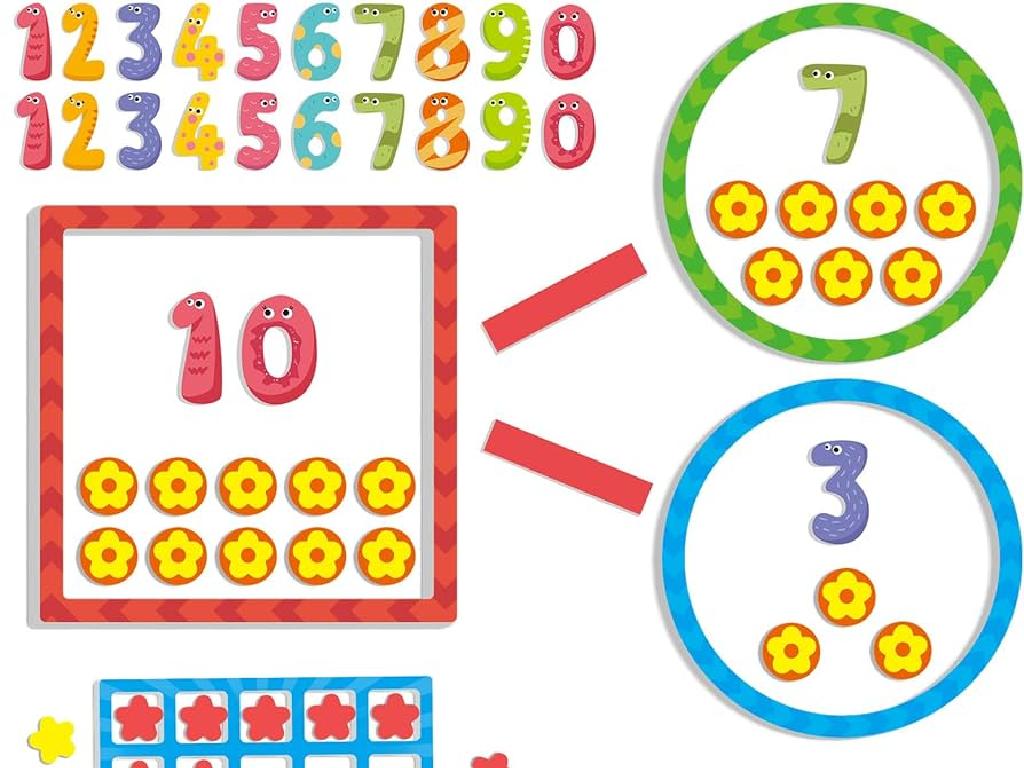Find Antonyms In Context
Subject: Language arts
Grade: Fifth grade
Topic: Synonyms And Antonyms
Please LOG IN to download the presentation. Access is available to registered users only.
View More Content
Today’s Adventure: Finding Antonyms in Context!
– What are antonyms?
– Antonyms are words with opposite meanings.
– Antonyms express opposites
– ‘Hot’ is the antonym of ‘cold’.
– Context helps find antonyms
– Words around the unknown word can hint at its antonym.
– Practice with examples
– We’ll use sentences to spot antonyms together.
|
This slide introduces the concept of antonyms to the students, explaining that they are words with opposite meanings. It’s important to highlight how context can help determine the antonym of an unknown word. Provide examples of antonyms and show how they are used in sentences to clarify their meanings. Encourage students to think of antonyms for words they already know and to use context clues in sentences to find antonyms. In the next class, practice with sentences from books or stories they are familiar with to reinforce the lesson.
Exploring Synonyms and Antonyms
– Synonyms: Words with similar meanings
– Antonyms: Words with opposite meanings
– Sentence examples with synonyms
– ‘Happy’ is a synonym for ‘joyful’ in ‘She felt happy/joyful about the surprise party.’
– Sentence examples with antonyms
– ‘Hot’ is an antonym for ‘cold’ in ‘The soup was hot, unlike the cold salad.’
|
This slide introduces the concept of synonyms and antonyms, which are fundamental to understanding and using language effectively. Synonyms are words that mean the same or nearly the same as another word, while antonyms are words with opposite meanings. Provide clear examples in sentences to illustrate how synonyms can be used interchangeably and how antonyms contrast with each other. Encourage students to think of additional examples and to use context clues in sentences to determine whether words are synonyms or antonyms. This understanding will enhance their vocabulary and reading comprehension skills.
Identifying Antonyms in Sentences
– Context clues reveal meanings
– Words or phrases around an unknown word can hint at its opposite meaning.
– How to find sentence antonyms
– Look for words that have the opposite meaning in the same sentence or nearby.
– Practice with ‘happy’
– Find a word that means the opposite of ‘happy’ in a sentence you read.
– Share your antonyms
|
This slide is aimed at teaching students how to use context to identify antonyms within sentences. Context clues are hints found within a sentence or passage that can help readers figure out the meaning of an unfamiliar word, often by looking at the words around it. When searching for antonyms, students should look for signal words or phrases that indicate contrast, such as ‘but’, ‘however’, or ‘unlike’. For the practice activity, students will find a word with the opposite meaning of ‘happy’ in a sentence, which will help them understand how context defines word meaning. Encourage students to think critically about word relationships and to use context as a tool for vocabulary development.
Using a Thesaurus: Finding Antonyms
– What is a Thesaurus?
– It’s a book of synonyms and antonyms.
– Using a Thesaurus for antonyms
– Look up a word to find its opposites.
– Activity: Find ‘quick’ antonyms
– Use a Thesaurus to find opposites of ‘quick’.
|
Introduce the thesaurus as a valuable tool for finding antonyms, which are words with opposite meanings. Explain that a thesaurus lists words grouped together based on similarity of meaning (synonyms) and also provides antonyms for many words. Demonstrate how to use a thesaurus by looking up the word ‘quick’ and finding its antonyms. For the activity, students will use a thesaurus to find and write down antonyms for ‘quick’. This will help them understand how to use context to determine the appropriate antonym. Teachers should prepare a list of antonyms for ‘quick’ such as ‘slow’, ‘sluggish’, ‘leisurely’, and ‘delayed’ to guide the activity and discussion.
Antonyms in Literature
– Discover antonyms in readings
– Find opposite-meaning words in books and poems
– Why authors use antonyms
– Antonyms can contrast, emphasize, or clarify ideas
– Class activity: Poem antonyms
– We’ll read a poem together and identify antonyms
– Enhance comprehension skills
|
This slide introduces the concept of antonyms within the context of literature. Students will learn how to identify antonyms in various texts and understand why authors might choose to use them to create contrast, emphasize points, or clarify meaning. During the class activity, select a short, age-appropriate poem and read it aloud with the class. Then, work together to spot and discuss the antonyms found within the poem. This exercise will help students recognize how antonyms can enhance their comprehension of a text. Encourage students to think critically about the author’s choice of words and how it affects their understanding of the poem.
The Power of Opposites: Antonyms in Writing
– Why writers use antonyms
– To contrast ideas and add interest
– Antonyms’ effect on tone
– They can make writing more dramatic or humorous
– Opposites attract in narratives
– Characters or themes often contrast to create conflict
– Activity: Find story antonyms
|
This slide aims to explore the use of antonyms in literature and how they can be a powerful tool for writers. Antonyms are words with opposite meanings that can be used to create contrast and emphasize differences in ideas, which can make the writing more engaging. They can also significantly affect the tone, making a piece of writing sound more serious, playful, or suspenseful. In stories, opposites are often used to attract and develop relationships or conflicts between characters, or to highlight contrasting themes. The class activity will involve students finding and discussing antonyms within a story, which will help them understand how opposites can add depth to narratives. Provide examples of antonyms and guide students on how to identify them in context.
Class Activity: Antonym Hunt
– Explore the classroom for opposites
– Find objects or words that are antonyms
– Discuss your antonyms with a partner
– For example, find ‘hot’ and ‘cold’ items
– Share your findings with the class
|
This interactive activity is designed to help students understand antonyms by finding real-life examples. Encourage them to look around the classroom for objects or words that are opposites, such as ‘light’ and ‘dark’ or ‘full’ and ’empty’. They can work in pairs to discuss their findings, which promotes collaborative learning. After the hunt, each pair will present their antonyms to the class, fostering public speaking skills. As a teacher, prepare to guide them with examples if they struggle and ensure every student participates. Possible variations of the activity could include drawing antonyms, writing sentences using them, or even creating an antonym word wall.
Create Your Own Antonym Story
– Write a short antonym story
– Include five pairs of antonyms
– Words like ‘hot’ and ‘cold’, ‘light’ and ‘dark’
– Use antonyms to shape your story
– Let the opposites add twist to the tale
– Share your story in class tomorrow
|
This activity is designed to help students understand and apply the concept of antonyms in a creative context. By writing a short story that includes at least five pairs of antonyms, students will practice identifying and using words with opposite meanings. Encourage them to think about how antonyms can change the direction of a story or highlight contrasts between characters or settings. Provide examples of antonyms for inspiration. Tomorrow, we will have a sharing session where each student will read their story aloud, fostering a supportive environment for creative expression and peer learning.






